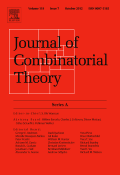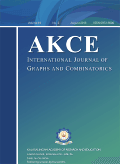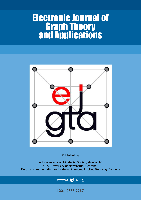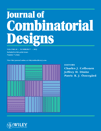
GRAPHS AND COMBINATORICS
Scope & Guideline
Connecting researchers through groundbreaking combinatorial insights.
Introduction
Aims and Scopes
- Graph Theory:
Focus on the foundational aspects of graph theory, including properties of different types of graphs, graph coloring, connectivity, and domination. - Combinatorial Structures:
Research on combinatorial designs, configurations, and arrangements that relate to graph theory, including hypergraphs and matroids. - Algorithm Development:
Emphasis on the creation and analysis of algorithms for solving graph-related problems, particularly in computational graph theory. - Extremal Graph Theory:
Study of extremal problems in graph theory, such as Turán-type problems and Ramsey theory, which investigate the conditions under which certain properties hold. - Spectral Graph Theory:
Exploration of the relationships between graph spectra and graph properties, investigating how eigenvalues and eigenvectors can inform us about graph structure. - Applications of Graph Theory:
Application of graph theoretical concepts to other fields such as computer science, biology, and social networks, showcasing interdisciplinary connections.
Trending and Emerging
- Dynamic and Adaptive Graph Algorithms:
An increasing focus on algorithms that adapt to changes in graph structures over time, reflecting real-world applications like network resilience and dynamic data analysis. - Random Graph Theory:
Growing interest in the properties of random graphs, particularly in connection with probabilistic methods and their implications for graph behavior under random conditions. - Graph Neural Networks and Machine Learning:
Emerging research on the application of graph theory to machine learning and neural networks, exploring how graph structures can enhance learning algorithms and data representation. - Topological Graph Theory:
Increased exploration of the connections between topology and graph theory, including studies on embeddings, planar graphs, and topological properties. - Interdisciplinary Applications:
A trend towards applying graph theoretical concepts to various fields, such as biology, sociology, and computer science, indicating a broader impact of graph theory in solving real-world problems.
Declining or Waning
- Classical Graph Coloring Problems:
Traditional coloring problems, while still relevant, appear to be receiving less emphasis compared to newer, more complex variations of graph coloring and dynamic coloring methods. - Elementary Graph Algorithms:
Basic algorithms for fundamental graph problems are becoming less frequently published, potentially overshadowed by more sophisticated approaches and applications in computational complexity. - Basic Extremal Graph Theory:
Foundational extremal graph theory topics, such as simple Turán problems, are less prominent as researchers explore more complex and nuanced variations of these problems. - Geometric Graph Theory:
Research focused on geometric aspects of graphs, such as intersection graphs and geometric representations, has seen a decrease in popularity, possibly due to a shift towards abstract combinatorial approaches.
Similar Journals

ELECTRONIC JOURNAL OF COMBINATORICS
Fostering Global Dialogue in Combinatorial ResearchELECTRONIC JOURNAL OF COMBINATORICS, an esteemed publication in the field of combinatorial mathematics, has been a significant platform for innovative research since its inception in 1996. Published by the ELECTRONIC JOURNAL OF COMBINATORICS, this open-access journal has made its complete repository freely available since 2014, encouraging broad international collaboration and dissemination of knowledge. The journal maintains a robust reputation, boasting various category quartiles including Q1 rankings in Applied Mathematics and Discrete Mathematics, highlighting its importance in advancing research and applications in these critical fields. With a clear commitment to showcasing high-impact work and contributing to the ongoing discourse in computational theories, the journal appeals to researchers, professionals, and students alike. Scholars can access a wide array of rigorous articles that explore the latest trends and developments in combinatorial techniques, geometry, and topology, making this journal an essential resource for anyone vested in mathematical sciences. For more information, please refer to their office based at the University of Delaware, Department of Mathematical Sciences.

JOURNAL OF COMBINATORIAL THEORY SERIES A
Fostering Breakthroughs in Computational Inquiry.JOURNAL OF COMBINATORIAL THEORY SERIES A, published by Academic Press Inc. Elsevier Science, stands as a pivotal platform for researchers in the realm of combinatorial mathematics and theoretical computer science. With an impact factor that underscores its influence and a well-respected reputation reflected in its rapid ascent to Q1 rankings in discrete mathematics and computational theory, this journal serves as a critical resource for academics seeking to advance their understanding of complex combinatorial structures and algorithms.
Founded in 1971, the journal covers a wide spectrum of topics within combinatorial theory, providing a robust forum for innovative research and theoretical advancements until 2025. Including a strong position in the Scopus rankings—notably, it ranks #10 out of 92 in discrete mathematics—the journal is essential for both emerging scholars and established professionals committed to pushing the boundaries of mathematical and computational inquiry. Researchers are encouraged to submit their findings to this esteemed publication, as it offers a non-open-access model that ensures rigorous peer review and high visibility within the academic community.

Communications in Combinatorics and Optimization
Elevating Research Standards in Combinatorial MathematicsCommunications in Combinatorics and Optimization is a prestigious open-access journal published by Azerbaijan Shahid Madani University, focused on advancing research in the fields of combinatorial mathematics and optimization. Since its inception in 2016, the journal has established a reputation for disseminating high-quality research, achieving a commendable Q2 ranking in both Control and Optimization and Discrete Mathematics and Combinatorics as of 2023. With a Scopus ranking of #13 in Discrete Mathematics and Combinatorics, it is positioned in the top 14% of its field, underscoring its significance in the academic community. By providing unrestricted access to its articles, the journal promotes the widespread dissemination of knowledge, fostering collaboration and innovation among researchers, professionals, and students around the globe. Based in Iran, the journal continues to contribute to the global discourse on effective combinatorial and optimization techniques that address contemporary challenges.

ARS Mathematica Contemporanea
Elevating Mathematical Discourse GloballyARS Mathematica Contemporanea, published by UP FAMNIT in Slovenia, stands as a pivotal journal within the fields of algebra, number theory, discrete mathematics, geometric topology, and theoretical computer science. Since its inception in 2011, this journal has consistently provided a rich platform for innovative research, garnering a commendable Q2 category ranking in various mathematical domains, including Algebra and Number Theory, and Geometry and Topology, showcasing its growing influence and prestige in the academic community. With an increasing Scopus rank—particularly notable in Algebra and Number Theory at the 71st percentile—ARS Mathematica Contemporanea is dedicated to publishing high-quality, peer-reviewed content that advances the frontiers of mathematical knowledge. The journal’s commitment to open access ensures that valuable research is readily available to scholars, practitioners, and students alike, fostering collaboration and dissemination of ideas across the globe. As it converges towards its dedicated timeline extending to 2024, ARS Mathematica Contemporanea remains a crucial resource for those engaged in mathematical research, presenting an array of theoretical and practical insights that define contemporary mathematical discourse.

Contributions to Discrete Mathematics
Elevating research standards in discrete mathematics.Contributions to Discrete Mathematics, published by the Department of Mathematics and Statistics at the University of Calgary, serves as a vital platform for disseminating innovative research within the dynamic field of discrete mathematics and combinatorics. Established in 2008, this journal has rapidly gained recognition, currently holding a Q3 classification in discrete mathematics and combinatorics for 2023. As it aims to foster academic dialogue and share groundbreaking discoveries, the journal showcases high-quality peer-reviewed articles that cover a range of topics, from theoretical explorations to practical applications. Although it currently operates under a traditional subscription model, there is a growing commitment to enhancing access options, ensuring that critical knowledge is available to researchers and practitioners alike. With its notable Scopus ranking of #50 out of 92 within its category, this journal is positioned as an important resource for students, academics, and industry professionals who seek to stay at the forefront of discrete mathematics research.

Journal of Combinatorics
Navigating the Landscape of Combinatorial InnovationsJournal of Combinatorics is a premier academic journal dedicated to advancing the field of combinatorial theory and its applications. Published by INT PRESS BOSTON, INC, it aims to provide a robust platform for researchers, professionals, and students to disseminate their findings and engage with cutting-edge developments in combinatorics. With a focus on high-quality, peer-reviewed articles, the journal fosters rigorous mathematical discussions surrounding various facets of combinatorial structures, graph theory, design theory, and combinatorial optimization. Although currently not available as an Open Access journal, the Journal of Combinatorics plays a vital role in enriching the mathematical sciences and serves as an essential resource for academics seeking to stay updated with the latest trends in combinatorial research. By maintaining a commitment to excellence and innovation, this journal is indispensable for anyone looking to deepen their understanding in this critical area of study.

AKCE International Journal of Graphs and Combinatorics
Fostering Global Collaboration in Discrete Mathematics.AKCE International Journal of Graphs and Combinatorics, published by TAYLOR & FRANCIS LTD, serves as a significant platform in the field of Discrete Mathematics and Combinatorics. With its commitment to open access since 2015, the journal ensures that cutting-edge research is readily available to a global audience, promoting the dissemination of knowledge and high-quality scholarship. Recognized for its impact in the discipline, the journal is currently ranked Q3 in its category for 2023 and holds a commendable Scopus ranking, falling within the 69th percentile. Researchers, professionals, and students alike will find invaluable insights and contributions in this journal, which spans a wide range of topics related to graph theory and combinatorial structures. Operating from its base in India, and converging from 2011 to 2024, the AKCE International Journal invites submissions that push the boundaries of mathematical exploration and foster innovative methodologies in a rapidly evolving field.

Electronic Journal of Graph Theory and Applications
Driving excellence in graph theory and its practical uses.The Electronic Journal of Graph Theory and Applications, published by Institut Teknologi Bandung, is a prominent open-access journal since 2013, dedicated to the dynamic field of graph theory and its various applications. With an ISSN of 2338-2287 and an impressive categorization in 2023, the journal stands at Q2 in both Applied Mathematics and Discrete Mathematics and Combinatorics, reflecting its growing influence and recognition within the academic community. With its geographical base in Bandung, Indonesia, the journal seeks to provide researchers, professionals, and students with a platform to disseminate innovative research and applications, bridging gaps in both theoretical and practical domains. The Scopus rankings further establish its commitment to excellence, notable as Rank #54/92 in Discrete Mathematics and Combinatorics and Rank #473/635 in Applied Mathematics. By facilitating open access to high-quality research, the Electronic Journal of Graph Theory and Applications significantly contributes to advancing scholarship and encourages diverse perspectives within the field.

FUNDAMENTA INFORMATICAE
Unveiling Insights in Computational Theory and Information Systems.FUNDAMENTA INFORMATICAE is a distinguished academic journal published by IOS PRESS, focusing on the critical intersection of informatics, mathematics, and computer science. Since its inception in 1988, this journal has served as a vital resource for researchers and professionals alike, providing a platform for innovative studies in Algebra and Number Theory, Computational Theory and Mathematics, Information Systems, and Theoretical Computer Science. With an impressive HIndex, and ranking in the Q3 and Q4 categories across various disciplines as of 2023, it underscores its contribution and relevance in advancing the body of knowledge in these fields. The journal's commitment to excellence is reflected not only in its rigorous peer-review process but also in its notable rankings on Scopus, which positions it favorably among its peers. Though not yet available as an open access journal, FUNDAMENTA INFORMATICAE remains a crucial academic venue for authors wishing to disseminate their findings to a global audience, promoting collaboration and further research within the scientific community.

JOURNAL OF COMBINATORIAL DESIGNS
Pioneering Research in Combinatorial ApplicationsJOURNAL OF COMBINATORIAL DESIGNS, published by Wiley, is a leading peer-reviewed journal that serves as a vital platform for researchers in the field of discrete mathematics and combinatorics. With an impressive Q1 ranking in the 2023 category, it stands at the forefront of academic discourse, showcasing significant developments and innovative research from 1993 to 2024. The journal is dedicated to the study of combinatorial designs, including their applications in various scientific disciplines, which enhances its relevance among mathematicians and applied scientists alike. Although it operates on a traditional subscription model, the journal continues to attract high-quality submissions, as evidenced by its Scopus rank of #40 out of 92 in Discrete Mathematics and Combinatorics, placing it in the 57th percentile. Its commitment to advancing knowledge in combinatorial theory and applications makes it an essential resource for professionals, researchers, and students seeking to deepen their understanding and contribute to this dynamic field.